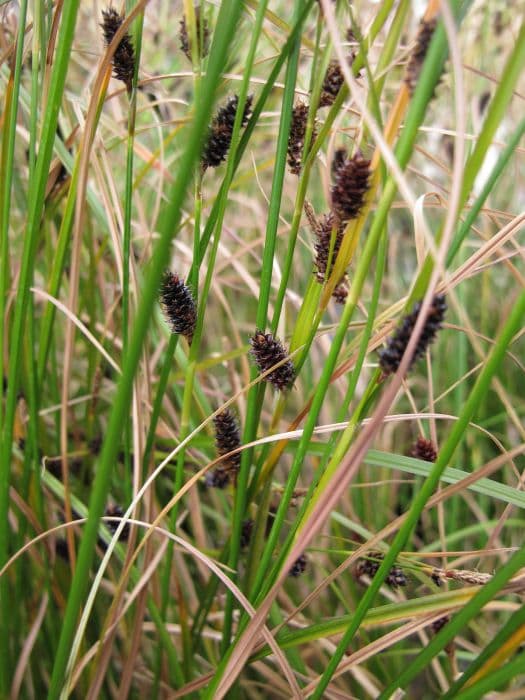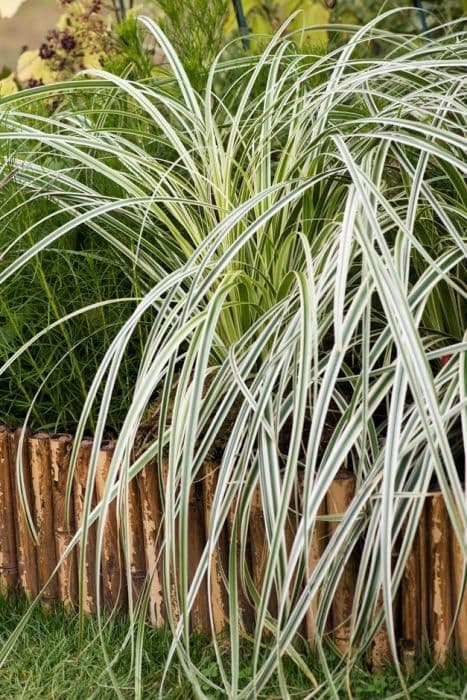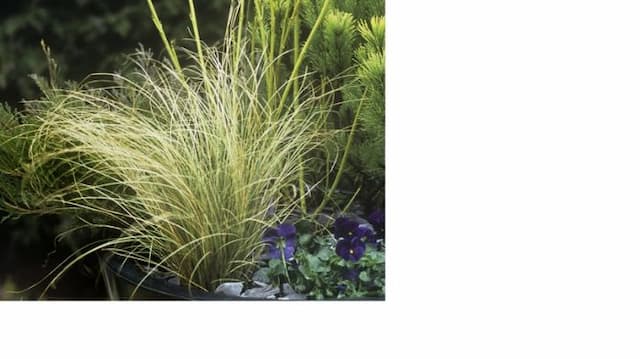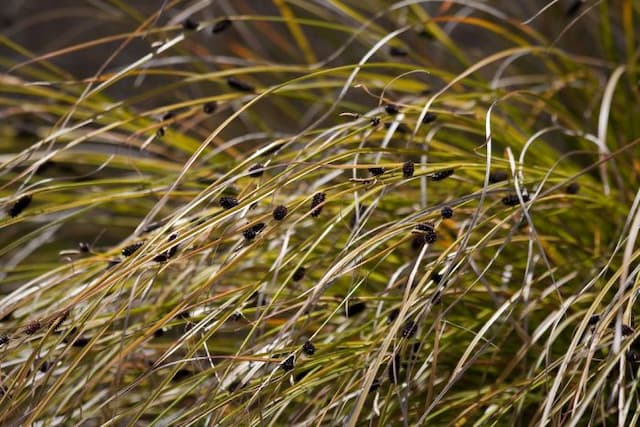Hairy sedge Carex hirta
















ABOUT
Carex hirta, commonly known as hairy sedge, is characterized by its distinct tufted appearance, with several stems emerging from a central base. The stems are triangular in shape and have a rough texture with a noticeable hairiness, which contributes to the name "hairy sedge." At the top of each stem, there are long, thin, grass-like leaves that are dark green and may also appear slightly rough or hairy, enhancing the overall bushy appearance of the plant. This plant is remarkable for its inflorescences, which are the parts that carry the flowers. The flower spikes are usually grouped towards the top of the stems, presenting a greenish-brown coloration that can be visually subtle. The flowers themselves are small and grow in clusters, not immediately noticeable unless looked at up close. They give way to small seed capsules which are similarly colored and can be found nestled among the upper leaves. Overall, the hairy sedge presents a wild and natural look, fitting well in grassy meadows and damp environments. It has a dense, clumping habit and carries a somewhat unkempt aesthetic due to its shaggy leaves and stems. Its ability to thrive in moist conditions makes it a common sight in wetland areas and alongside bodies of water.
About this plant
 Names
NamesFamily
Cyperaceae.
Synonyms
Hairy Sedge, European Weed.
Common names
Carex hirta var. vulgaris, Carex hirta var. ericetorum
 Toxicity
ToxicityTo humans
Carex hirta, commonly known as hairy sedge, is not widely recognized for having notable toxicity to humans. There is limited information suggesting that it poses a significant health threat when ingested. As with many plants, individual allergic reactions are possible, but general toxicity leading to poisoning symptoms is not commonly reported. Caution is always advised when dealing with unfamiliar plants, as sensitivity can vary among individuals.
To pets
Hairy sedge is also not widely known for being toxic to pets. There are no specific, well-documented cases of poisoning in domestic animals such as cats and dogs from ingesting this plant. As a general precaution, it is a good practice to keep an eye on pets and prevent them from consuming large amounts of any non-food plants, as individual animals can have unique reactions, and stomach upset or an obstruction could occur if large amounts are ingested.
 Characteristics
CharacteristicsLife cycle
Perennials
Foliage type
Evergreen
Color of leaves
Green
Flower color
Brown
Height
2 feet (60 cm)
Spread
2 feet (60 cm)
Plant type
Herb
Hardiness zones
5
Native area
Europe
Benefits
 General Benefits
General Benefits- Erosion Control: Carex hirta, commonly known as Hairy Sedge, is effective at stabilizing soil and preventing erosion, particularly in wet areas.
- Habitat Provision: It provides a natural habitat and food source for a variety of wildlife, including birds and insects.
- Water Filtration: The plant naturally filters and purifies water by trapping sediments and utilizing nutrients, improving water quality in its vicinity.
- Landscape Aesthetics: Hairy Sedge offers textural contrast and visual interest in natural landscaping designs, as well as in rain gardens and wetland restorations.
- Biodiversity Support: By hosting and supporting different species, Carex hirta contributes to the overall biodiversity of an ecosystem, which is crucial for environmental health.
- Low Maintenance: Once established, it requires minimal care, making it a good choice for low-maintenance landscaping.
- Drought Resistance: While it thrives in moist conditions, Carex hirta is also capable of withstanding periods of drought, making it versatile for various landscapes.
- Tolerance to Conditions: Hairy Sedge is generally tolerant of a range of conditions including poor soils, varying pH levels, and cold temperatures.
 Medical Properties
Medical PropertiesThis plant is not used for medical purposes.
 Air-purifying Qualities
Air-purifying QualitiesThis plant is not specifically known for air purifying qualities.
 Other Uses
Other Uses- Carex hirta, commonly known as Hairy Sedge, can be used in the creation of green roofs for its ability to tolerate both wet and dry conditions, contributing to urban biodiversity conservation.
- Hairy Sedge can be incorporated into living walls or vertical gardens due to its adaptability and low maintenance characteristics, adding texture and greenery to urban landscapes.
- The sturdy and dense clumps formed by Hairy Sedge make it a useful plant for controlling soil erosion on slopes or in areas prone to degradation.
- It can be planted alongside streams or on the banks of ponds to stabilize the soil and prevent erosion, while providing natural habitat for wildlife.
- Hairy Sedge can be utilized in sustainable landscaping to create naturalistic garden designs that require minimal inputs of water, fertilizers, and pesticides.
- The fibers from Carex hirta can be used in traditional basket-weaving practices, contributing to the preservation of handicraft skills.
- Dried clumps of Hairy Sedge can be fashioned into eco-friendly brooms for sweeping loose soil or leaves in outdoor settings.
- As a component of mixed meadows, Hairy Sedge can provide seasonal interest and support a diversity of insects, which are crucial for pollination and ecosystem health.
- It can serve as a protective cover for ground-nesting birds, offering shelter and nesting material with its leaves and dry inflorescences.
- The seeds of Hairy Sedge are a source of food for certain bird species, thereby playing a role in sustaining avian populations and encouraging biodiversity.
Interesting Facts
 Feng Shui
Feng ShuiThe Hairy sedge is not used in Feng Shui practice.
 Zodiac Sign Compitability
Zodiac Sign CompitabilityThe Hairy sedge is not used in astrology practice.
 Plant Symbolism
Plant Symbolism- Resilience: As a hardy grass, the Hairy Wood Rush represents resilience, thriving in various conditions where other plants might not survive. Its robust nature symbolizes the ability to endure challenging situations.
- Adaptability: The Hairy Wood Rush, being adaptable to a wide range of environments, symbolizes flexibility and the ability to adjust to changing circumstances.
- Protection: This plant often provides shelter and protection for wildlife within its dense foliage, signifying shelter and safety.
 Water
WaterThe common name for Carex hirta is Hairy Sedge. When watering Hairy Sedge, the soil should be kept consistently moist but not waterlogged. During the growing season, water the plant deeply once a week with approximately 1-2 gallons, depending on the size of the plant and the environmental conditions. In hot or windy weather, you may need to water it more frequently, and during the winter, you can reduce watering to every other week or when the soil feels dry to the touch. It's important to ensure that the pot has good drainage to avoid standing water at the roots.
 Light
LightHairy Sedge prefers full to partial sunlight depending on the climate. In cooler regions, this plant will thrive in full sun, whereas in hotter areas, it benefits from partial shade, especially during the peak afternoon hours. The best spot for Hairy Sedge is where it can receive at least four to six hours of sunlight a day, making it suitable for a sunny border or as an accent in a mixed planting.
 Temperature
TemperatureHairy Sedge is tolerant of a wide range of temperatures but grows best in conditions that mimic its natural temperate environment. It can generally withstand temperatures down to about 20°F and up to 90°F. The ideal temperature for this plant is between 60°F and 75°F for optimal growth. It is a hardy plant and can survive brief periods outside these ranges but should be protected from extreme temperature shifts.
 Pruning
PruningPruning Hairy Sedge helps to maintain its shape and remove any dead or damaged foliage. It should be pruned in early spring before new growth begins. Cut back the plant to about 2-3 inches above ground level to allow for fresh growth. This process, done once a year, will rejuvenate the plant and keep it looking tidy.
 Cleaning
CleaningAs needed
 Soil
SoilHairy Sedge thrives best in a moist, well-draining soil mix with a pH range of 5.5 to 7. A mixture incorporating loamy soil, compost, and coarse sand is ideal to facilitate proper drainage and provide organic nutrients. Regularly adding organic matter will help maintain the soil's moisture and nutrient levels, supporting healthy plant growth.
 Repotting
RepottingHairy Sedge should be repotted every 2-3 years to refresh the soil and accommodate root growth. It is best to repot in the spring when the plant is entering a period of active growth, which allows it to recover from the disturbance more easily.
 Humidity & Misting
Humidity & MistingHairy Sedge prefers high humidity levels but is adaptable to a range of conditions. For best growth, maintaining a humidity level of around 60% is ideal. In drier environments, grouping plants or using a humidity tray can help increase local humidity around the plant.
 Suitable locations
Suitable locationsIndoor
Place Hairy Sedge in bright, indirect light and keep soil moist.
Outdoor
Plant Hairy Sedge in partial shade and keep soil consistently moist.
Hardiness zone
5-9 USDA
 Life cycle
Life cycleCarex hirta, commonly known as "Hairy Sedge," begins its life cycle as a seed, which germinates in moist, suitable soil conditions typically during the spring. Seedlings emerge and develop into juvenile plants with a rosette of grass-like leaves. The plant undergoes vegetative growth, developing a dense clump of foliage and spreading by rhizomes to form a larger colony. Throughout the late spring and summer, Hairy Sedge produces flowering culms, with small, inconspicuous flowers grouped in spikes on the stem; these flowers are wind-pollinated. After pollination, the plant sets seed in small, green to brown utricles (a bladder-like sac that encloses the seed), which, when mature, disperse to start the cycle anew. Over the years, mature plants may divide and spread through vegetative reproduction, ensuring the persistence of Hairy Sedge in its habitat.
 Propogation
PropogationPropogation time
Spring to Summer
The most popular method of propagating Carex hirta, commonly known as Hairy Sedge, is by division. This plant can be propagated in the spring when it starts to actively grow again after the winter season. To propagate through division, carefully lift the parent plant from the ground using a garden fork, ensuring you do not damage the root system. Break apart the clump into smaller sections, each with a healthy amount of roots and shoots, ideally with your hands to minimize damage, though using a sharp knife may be necessary for tough, dense clumps. Plant these divisions immediately at the same soil depth they were growing at before, space them about 12 to 18 inches (approximately 30 to 45 centimeters) apart to allow ample room for growth. Water the new plants thoroughly after planting to help establish them. This method is effective because Hairy Sedge forms dense tufts and can recover quickly from division, making it relatively simple to increase your stock of plants.









